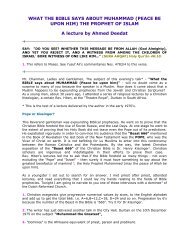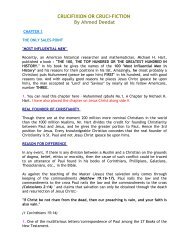Collection Of Articles (Refuting Shia) - Enjoy Islam
Collection Of Articles (Refuting Shia) - Enjoy Islam
Collection Of Articles (Refuting Shia) - Enjoy Islam
You also want an ePaper? Increase the reach of your titles
YUMPU automatically turns print PDFs into web optimized ePapers that Google loves.
Iran and the Revolution: An exposure of the American Plans<br />
Page 4 of 19<br />
series of bilateral economic sanctions on Iran and began an ominous military buildup in the region.<br />
In September 1951, British officials began implementing a plan to invade southwestern Iran and<br />
seize the oil fields. When US officials were told about this plan, President Truman notified British<br />
Prime Minister Clement Attlee that the US would not support an invasion and urged him to resume<br />
negotiations with Iran over the oil dispute. As a result, Attlee was force to abandon the invasion<br />
plan, telling his cabinet that "in view of the attitude of the United States government, [he did not]<br />
think it would be expedient to use force" in Iran. 12 Soon after the oil nationalization law was<br />
enacted, US officials began to implement a plan to ease the effect of the British oil blockade on the<br />
world oil market. Under this plan US oil companies were asked to provide oil to US allies that had<br />
been adversely affected by the blockade. Although this effort was intended to help stabilize the<br />
world oil market, it also reinforced the oil blockade and therefore inadvertently helped to weaken the<br />
Iranian economy and undermine Mussadiq's popular support. At the same time, US officials began a<br />
concerted effort to facilitate a negotiated settlement of the oil dispute. They advised the British to<br />
accept nationalization of the AIOC and agree to a 50/50 division of profits with Iran. However, the<br />
attempt failed.<br />
US Strengthens Its Foothold In Iran<br />
A few months latter, US was able to strike a secret deal with Shah's sister, Princess Ashraf.<br />
In the deal, Iran conceded production and marketing rights which were given to a consortium,<br />
including 40% US participation. This formally ended the British oil monopoly in Iran.13After the deal<br />
was reached by the Americans, the CIA officers in Tehran began to turn some of their anti-Soviet<br />
covert operations in directions that undermined Mussadiqis base of support. Under a propaganda<br />
operation code-named BEDAMN, they distributed newspaper articles and cartoons that depicted<br />
Mussadiq as corrupt and immoral and portrayed him as exploiting Aytullah Kashani. They provided<br />
financial assistance to certain clergymen to drive them away from Mussadiq. CIA officers had longstanding<br />
ties to the Pan-Iranist Party and the Toiler's Party (both had strongly supported Mussadiq)<br />
made efforts to turn these organizations against Mussadiq. In a particular noteworthy case, two CIA<br />
officers in the fall of 1952 approached Baqai, who had headed the Toiler' Party, encouraging him to<br />
break with IRAN ARTICLE FROM KHALIFORNIA Page 6 of 7<br />
Mussadiq and giving him money. Similar approaches may have been made to Kashani, Makki. and<br />
other prominent figures."l4 By November 1952 both the Pan-Iranists and Toilersi Party had split into<br />
pro and anti-Mussadiq factions; Kashani, Makki, Baqai, and other National Front leaders had openly<br />
turned against Mussadiq, thanks to the heavy covert efforts by the CIA. Hand in hand with the CIA,<br />
the British were carrying out very similar, but more extensive covert activities against Mussadiq.<br />
Christopher Montague Woodhouse, who had been heading British intelligence operation in Iran, was<br />
sent to Washington in November to present US officials with a plan to oust Mussadiq.15 The plan<br />
called for a coordinated uprising to be engineered by the Rashidians and certain Bakhtiari tribal<br />
elements, with or without the Shahis approval. On February 3, 1953, two weeks after the<br />
Eisenhower inauguration, top US and British officials met in Washington and made a decision to<br />
develop and carry out a plan to work together in order to over throw Mussadiq. By using the<br />
BEDAMN network, CIA carried out extensive propaganda barrage against Mussadiq and organized<br />
antigovernment and anti-Tudeh demonstrations, adding considerably to the turmoil that was<br />
engulfing Tehran. They sought the support of top military officers, arranging to have certain army<br />
units participated in the coup.<br />
Finally, Mussadiq fell in August of 1953. With Mussadiq out of the way, the Eisenhower<br />
administration rushed to support General Zahedi, who had already been chosen to replace<br />
Mussadiq as the prime minister. The US provided Iran with $68 million, mounting to roughly one<br />
third of the total revenue Iran had lost as a result of the British oil embargo. Over $300 million in<br />
additional US economic aid was given to Iran during the next ten years. The United States also<br />
began a major effort to strengthen Shah's security forces soon after the coup, reorganizing and<br />
training his domestic intelligence apparatus and giving him almost $600 million in military assistance<br />
during the next decade. l6 As a result, Iran's economy grew rapidly. With the more effective security<br />
apparatus in place, Shah consolidated his grip on power in the late 1950s and early 1960s. By late<br />
1963, this process had been completed: Shah presided over an authoritarian, repressive regime<br />
under which organized opposition to his authority was not tolerated, and there seemed little chance<br />
http://islamicweb.com/beliefs/cults/iranian_revolution.htm<br />
1/28/2005
















